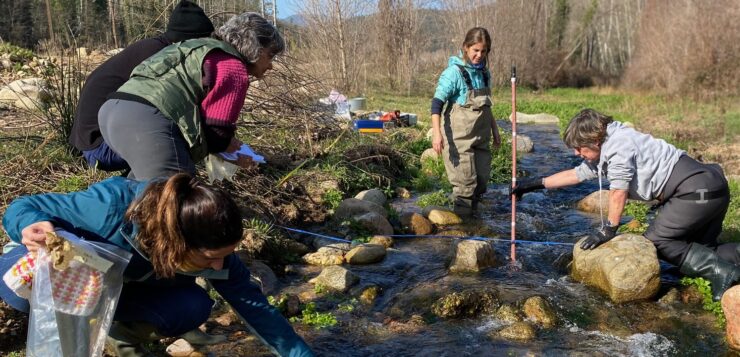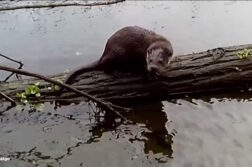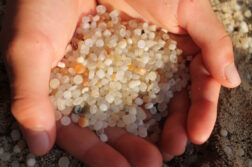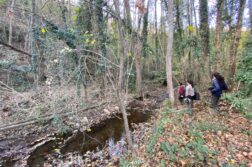A new research project by the Advanced Studies Center of Blanes (CEAB-CSIC) analyzes how continuous droughts, other extreme phenomena, and the intense human pressure on these rivers condition the accumulation and transport of plastic waste.
The project (called APOM-Cycling) has begun this February with the first field samplings. They are carried out in the La Tordera river, periodically and in twelve areas of four differentiated sub-basins. Sampling points have been chosen to be representative of the common characteristics of Mediterranean rivers, as well as the variations among them, such as different human activities surrounding them. Therefore, forested areas, others with agricultural or livestock activity, and finally, more urban areas have been chosen.
The scientists from CEAB-CSIC conducting the project collect numerous samples. They are taken from visible plastics, both from those on the shore and within the river channel. They also collect sediments, samples of different types of aquatic vegetation, biofilms and water samples. Right there, with the help of sieves and nets with filters of different sizes for meso and microplastics, they make an initial assessment of the degree of plastic pollution and the typology and origin of the plastics. Subsequently, all samples are analyzed in the laboratory to quantify the plastics found, understand their composition and origin, see how they degrade, where they end up, which points or organisms they adhere to, and how they are transported. The work also allows understanding the general health status of the river and the impact of this type of pollution.
In addition to fieldwork, the project includes experimentation in artificial channels, where the conditions found in Mediterranean rivers are simulated in a controlled manner. This part is carried out in the laboratories of the CEAB-CSIC headquarters in Blanes and in the Urban River Lab, located at the Montornès del Vallès wastewater treatment plant.
The objective of the research is to understand how the different circumstances found in our rivers determine the retention and transport of plastic waste: what role sediments, biofilms, and aquatic vegetation of the river channel play in plastic retention, and what is the effect of droughts and floods on retention and transport. Above all, the aim is to find out what happens to plastic waste when rivers are almost or completely dry and how this pollution depends on land use in the basin and different human activities.
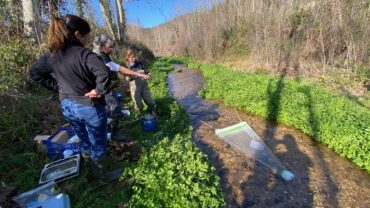
Helena Guasch, one of the scientists from CEAB-CSIC conducting the research, explains, “We are investigating the influence of different land uses on the presence of macro, meso, and microplastics, the contribution of river morphology, eutrophication (due to high concentrations of nitrogen and phosphorus), and droughts and floods.” She adds, “We start from the hypothesis that when there is no water, plastics tend to be retained in the river, among sediments, and when a flood comes, the sediment is stirred up, and plastics are transported downstream. But we want to objectify it and go further. We aim to obtain a model of the dynamics, both spatially and temporally, of plastics in our rivers in the context of climate and global change.”
Eugènia Martí, another researcher on the team, recalls that this work can be important not only for continental ecosystems but also for marine ones since “rivers act as conduits or viaducts for plastic waste generated on continents, which ultimately reaches the sea.” In fact, 80% of the waste found in the sea come from land.
Researcher Delfina Cornejo points out another objective of the project: raising awareness. “In addition to research work, we would like to contribute to raising awareness. All plastic pollution comes from humans. We can do a lot, both collectively, by moving towards other models of society, and individually.”
The APOM Cycling team plans to carry out outreach activities within the project to reach the public and make it an ally in the fight against overexploitation and pollution of river ecosystems.


